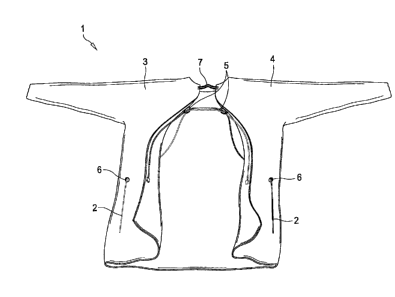Some of the information on this Web page has been provided by external sources. The Government of Canada is not responsible for the accuracy, reliability or currency of the information supplied by external sources. Users wishing to rely upon this information should consult directly with the source of the information. Content provided by external sources is not subject to official languages, privacy and accessibility requirements.
Any discrepancies in the text and image of the Claims and Abstract are due to differing posting times. Text of the Claims and Abstract are posted:
| (12) Patent: | (11) CA 2851001 |
|---|---|
| (54) English Title: | MEDICAL GOWN |
| (54) French Title: | BLOUSE MEDICALE |
| Status: | Granted |
| (51) International Patent Classification (IPC): |
|
|---|---|
| (72) Inventors : |
|
| (73) Owners : |
|
| (71) Applicants : |
|
| (74) Agent: | BERESKIN & PARR LLP/S.E.N.C.R.L.,S.R.L. |
| (74) Associate agent: | |
| (45) Issued: | 2016-11-29 |
| (22) Filed Date: | 2014-05-02 |
| (41) Open to Public Inspection: | 2015-05-20 |
| Examination requested: | 2014-12-12 |
| Availability of licence: | N/A |
| (25) Language of filing: | English |
| Patent Cooperation Treaty (PCT): | No |
|---|
| (30) Application Priority Data: | ||||||
|---|---|---|---|---|---|---|
|
A gown with an opening to allow passage the user's head allowing the gown to rest on the user's shoulders and an opening in the back with one cord attached to the inside of each side of the opening in the back of the gown and each cord then extends toward the shoulder area where each cord is temporarily attached and the cord further extends toward a hole in the opposite side of the opening in the back where it passes through a hole to the outer portion of the gown.
Une blouse pourvue dune ouverture pour permettre le passage de la tête de lutilisateur afin que la blouse repose sur ses épaules et dune ouverture à larrière avec un cordon fixé à lintérieur de chaque côté de louverture à larrière de la chemise. Chaque cordon sétend alors vers la zone des épaules et y est fixé temporairement, puis le cordon sétend davantage vers un trou dans le côté opposé de louverture à larrière où il passe à travers un trou vers la partie externe de la blouse.
Note: Claims are shown in the official language in which they were submitted.
Note: Descriptions are shown in the official language in which they were submitted.

For a clearer understanding of the status of the application/patent presented on this page, the site Disclaimer , as well as the definitions for Patent , Administrative Status , Maintenance Fee and Payment History should be consulted.
| Title | Date |
|---|---|
| Forecasted Issue Date | 2016-11-29 |
| (22) Filed | 2014-05-02 |
| Examination Requested | 2014-12-12 |
| (41) Open to Public Inspection | 2015-05-20 |
| (45) Issued | 2016-11-29 |
There is no abandonment history.
Last Payment of $347.00 was received on 2024-04-23
Upcoming maintenance fee amounts
| Description | Date | Amount |
|---|---|---|
| Next Payment if standard fee | 2025-05-02 | $347.00 |
| Next Payment if small entity fee | 2025-05-02 | $125.00 |
Note : If the full payment has not been received on or before the date indicated, a further fee may be required which may be one of the following
Patent fees are adjusted on the 1st of January every year. The amounts above are the current amounts if received by December 31 of the current year.
Please refer to the CIPO
Patent Fees
web page to see all current fee amounts.
| Fee Type | Anniversary Year | Due Date | Amount Paid | Paid Date |
|---|---|---|---|---|
| Application Fee | $400.00 | 2014-05-02 | ||
| Request for Examination | $800.00 | 2014-12-12 | ||
| Maintenance Fee - Application - New Act | 2 | 2016-05-02 | $100.00 | 2016-04-20 |
| Final Fee | $300.00 | 2016-10-20 | ||
| Maintenance Fee - Patent - New Act | 3 | 2017-05-02 | $100.00 | 2017-04-24 |
| Maintenance Fee - Patent - New Act | 4 | 2018-05-02 | $100.00 | 2018-04-23 |
| Registration of a document - section 124 | $100.00 | 2018-09-05 | ||
| Maintenance Fee - Patent - New Act | 5 | 2019-05-02 | $200.00 | 2019-04-19 |
| Maintenance Fee - Patent - New Act | 6 | 2020-05-04 | $200.00 | 2020-04-20 |
| Maintenance Fee - Patent - New Act | 7 | 2021-05-03 | $204.00 | 2021-04-19 |
| Maintenance Fee - Patent - New Act | 8 | 2022-05-02 | $203.59 | 2022-04-19 |
| Maintenance Fee - Patent - New Act | 9 | 2023-05-02 | $210.51 | 2023-04-25 |
| Maintenance Fee - Patent - New Act | 10 | 2024-05-02 | $347.00 | 2024-04-23 |
Note: Records showing the ownership history in alphabetical order.
| Current Owners on Record |
|---|
| GROUPE MEDICOM INC./MEDICOM GROUPE INC. |
| Past Owners on Record |
|---|
| LEVINE, IAN |